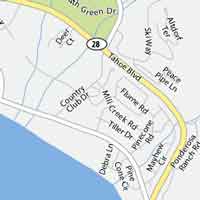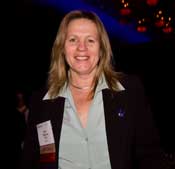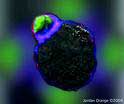The IACFS/ME Conference II: the Hit of the Conference
The Whittemore-Peterson Neuro-Immune Institute



Reno, Nevada: March 12-16, 2009
By Cort Johnson
“You just keep showing these guys compelling data. We have a piece of data that would just knock your socks off but I’m not showing it. ” Dr. Judy Mikovits

The Whittemore-Peterson Neuro-immune Institute was the hit of the conference. They appear to have more further quickly than any ME/CFS research effort has to date. One reason has been their decision to focus one subset. Dr. Peterson has conjectured that this subset – often referred to as the Incline Village Cohort – makes up somewhere around 20-30% of the chronic fatigue syndrome (ME/CFS) population. This group typically has abnormal RNase L readings, poor NK cell functioning, increased pathogen loads and an acute infectious onset. Many are in the original Incline Village Cohort that thrust this disease into the media spotlight almost 25 years ago.
Documenting A Unique Circle of Dysfunction
The WPI’s first goal was to tease this group out from the mass of ME/CFS patients – to establish, contrary to most researchers and physicians beliefs – that there is a unique acute onset ‘viral’ group of patients. Amazingly they appear to have been able to do that.
The reason they were able to do this is that some of these patients appear to be reaping the rewards of government inattention – they’re dying of cancer. The federal government doesn’t care if patients linger in a disabled state for decades, straining (breaking) the social safety net, costing themselves, their families and society enormous amounts of emotional and financial distress. That apparently doesn’t interest the federal government in the slightest. But if you have cancer, even if only a very few patients have cancer – that will get the feds attention.
Dr. Peterson’s finding that a few of his patients were coming down with very rare cancers got one researchers attention. Once she got interested other researchers became interested and it wasn’t long before tests on samples from dozens of ME/CFS patients were undergoing state of the art testing at the National Cancer Institute. The cancer was the ME/CFS community’s ‘in’.
Once the WPI got their toe in the door they got to work showing that, cancer or not, that this crazy disease was real. If they can do that with this subset then maybe they can open the door wide enough to squeeze the rest of us in. The first step, though, was establishing that for some patients their reward for 25 years of battling this mysterious disease was coming down with cancer – a bitter, bitter reward indeed.
Unsettling Associations: The Incline Village Cancer Cluster
Of all the problems associated with ME/CFS one would have hoped that the ‘Big C’ wouldn’t be one of them. But the evidence presented at the conference suggests that at least with this particular cohort of patient it’s a very real problem.
Dr. Peterson got Dr. Mikovits, a cancer researcher, interested when he mentioned at a conference in Spain that he had nine patients with Non-Hodgkins Lymphoma (NHL). NHL strikes about 2 out of every 10,000 people in the US (0.02%) but a full 5% of Dr. Peterson’s Nevada cohort had developed it. Even more striking was the type of specific of type of lymphoma he was finding.
Mantle Cell Lymphoma is a form of non-Hodgkins Lymphoma (NHL) that is almost vanishingly rare. If my back of the envelope statistics are correct MCL strikes about 1 out of every 100,000 people …but thirty percent of Dr. Peterson’s ME/CFS cancer patients had it. That’s the kind of finding that will turn a cancer researchers head and it got Dr. Mikovits, a viral cancer researcher associated with the HHV-6 Foundation’s attention. She told me she knew right away that ‘that’s a virus’. She was soon off for the summer to Reno to look more closely at this cohort.
 Dr. Gagen, a biostatician was engaged to take closer look at this cohort. Was it real? Her presentation was fascinating. She began to work her way down her slides of the region. Yes there was a large cluster of cancer cases in the general area. But where exactly was it? She ticked down several slides narrowing the focus and then there it was – one brightly highlighted section almost pulsing out at you Incline Village. It was an eerie moment. Even she said she was surprised to see that location pop out so vividly.
Dr. Gagen, a biostatician was engaged to take closer look at this cohort. Was it real? Her presentation was fascinating. She began to work her way down her slides of the region. Yes there was a large cluster of cancer cases in the general area. But where exactly was it? She ticked down several slides narrowing the focus and then there it was – one brightly highlighted section almost pulsing out at you Incline Village. It was an eerie moment. Even she said she was surprised to see that location pop out so vividly.
(Most people in Dr. Peterson’s cohort do not have cancer but enough of them do have these rare cancers to make the group stand out. Dr. Peterson pointed out two patients in an early North Carolina cohort with this type of cancer but what about other physician’s patients? If they’re there we haven’t heard of them. At a recent seminar Dr. Peterson recommended that physicians with long-term patients screen them for cancer.)
The cancer subset was real. Now the search was on to find its cause. Dr. Mikovits, our connection to the National Cancer Institute, felt it had to be a virus. But which one? The WPI set out to find out. But first a little about the lead researcher at the WPI.
They’re BAAACK
 Identification of Differentially Expressed Viruses in American CFS Patients Probed with a Custom Mammalian Virus Microarray. Judy Mikovits, V. Lombardi, Y. Huang, D. Peterson and F. Ruscetti
Identification of Differentially Expressed Viruses in American CFS Patients Probed with a Custom Mammalian Virus Microarray. Judy Mikovits, V. Lombardi, Y. Huang, D. Peterson and F. Ruscetti
Dr. Mikovits, the head researcher at the WPI brings not just a steel-sharp mind that was honed in the rigorous environment of the National Cancer Institute but all the connections she’s developed over the years.
The two most prominent positions on a citation are the first (the researcher who did all the work) and the last (the senior researcher backing up the effort). Take a look at the senior (last) author of the paper, Frank Ruscetti. Frank Ruscetti is the head of the white blood cell biology section of the National Cancer Institute at the NIH – a big wheel who discovered the interleukin 2 cytokine and was prominent in AIDS research. Researchers look a bit more closely at a paper when the senior author is the head of a lab at the National Cancer Institute. It’s probably safe to say that no researcher of his stature had co-authored a paper on ME/CFS before.
Interlude: I got to talk to Dr. Mikovits at the conference. ME/CFS has had trouble attracting new researchers to the field so the first thing I asked her was how she got started in all this?
I was consulting with Kristin Loomis of the HHV-6 Foundation at the time (summer of 2006). At the last talk of the (HHV-6) conference (in Spain) Dr Dan Peterson described the cancer group he’d found and specifically the molecular defect in the immune system something called a clonal receptor re-arrangement which you don’t see unless you have a persistent unresolved infection or lymphoma . At the end of the talk he said “Well I don’t what to make of this and we have like 10 of these patients “.
I think an immunologist stood up and said “Oh, all old people get that” but I was thinking that the problem is that these people aren’t old. These people were getting a very rare lymphoma and they were getting it before anyone gets lymphoma and to me that says virus.
My background is in virus caused cancers. My training for over 22 years at the National Cancer Institute was in how viruses dysregulate the immune response to cause disease cancer. So when he said come meet with me after the talk and I beat up to the front of the room because it was the only interesting thing I’d heard during the entire meeting (laughing) and I said “There’s something there that’s a smoking gun” so I gave him my card, told him I’m interested, told him what I thought was going on and he and Annette Whittemore invited me out to Reno. Within two weeks of that meeting they talked about setting up a summer research program….
Dr. Mikovits brought more than connections – she also brought technology. The pathogen microarray she used comes straight from the National Cancer Institute. It’s the most definitive pathogen microarray in the world. (Microarray’s search for bits of RNA and DNA unique to a pathogen. If they find these unique sequences they’re confident that the actual pathogen is present.) This one looked for evidence of all known mammalian viruses.
“When you see 8-10 cases of mantle cell lymphoma in Northern Nevada and California – that’s a pathogen. So we said first off we’re going to do a viral microarray to look for it. That chip (viral microarray) holds multiple (aspects) of every known mammalian viruses. So there’s not one (aspect) of of EBV we’re looking at there’s 60 or 70 so you can look at multiple parts of the virus.” Dr. Mikovits
What popped out in them? Our old ‘favorite’ the herpes viruses. What popped out in the healthy controls? Their old favorite common cold viruses (rhinoviruses/adenoviruses). Which herpes viruses? HHV5, 7, cytomegalovirus, HHV-6. Cytomegalovirus was the most active virus found. Human endogenous retroviruses a subject of the Symposium on Viruses in CFS – were also found. So were enteroviruses. Dr. Mikovits said the levels of viral expression they found were ‘incredible’.
“The average chronic fatigue syndrome patient on the day they were tested had between 30-50 viruses; the average control had 3 or 4” Dr. Daniel Peterson, 2008 Swedish Conference
Not only that but they found that these patients had a distinctive viral signature; in fact it’s distinctive enough that the WPI believes it’s a diagnostic for them i.e. it’s a biomarker for this group. It’s essentially a series of tests that can (and is) being put on a chip that physicians can easily run to determine if the fatigued patient before them fits this profile. What is ‘it’ identifying? It’s identifying the viral subset in ME/CFS. If the WPI is successful at doing this they’ll cut a significant group of patients free from the chronic fatigue syndrome label.
Dig Deeper! Dr. Peterson’s 2008 Presentation in Sweden
(But what to call this new disease? ‘Peterson’s Disease’? Incline Village Immune Dysfunction (IVID?) How about myalgic encephalomyelitis – this is, after all the viral group. Annette Whittemore has said she’d be fine with that. Whatever it turns out to be somehow one has the feeling it won’t have the word fatigue in it.)
If it all works out it’ll be a defining moment in the history of this disease. A lot changes when you isolate out a subset. For one thing you finally have a distinct research focus. Since you don’t have all these other types of patients that were bollixing up your data you should start getting more consistent study results which is exactly what happened here. Plus once you separate out this group it should get easier to find the subsets in the rest of the ME/CFS population because once you’ve removed this group it’s not obscuring the view for the rest of us.
The ME/CFS community can’t really begin cheering until studies replicate this subset in other patient groups and until doctors are using this new test or (‘chip’) and reporting success with it. We should know pretty soon the chip is reportedly done, licensing and patenting are apparently just about done this thing is moving along fast. If it works out it’ll be the biggest development in ME/CFS since…..well, since Incline Village hit the news 25 years ago. Uncovering documentable subgroups has been on the top of researchers lists almost from day one.
They demonstrated the cancer cluster is real. Now, apropos to Dr. Mikovits remarks (‘that’s a virus’) they found evidence of viruses. If a virus (or more likely a group of viruses) is the problem then that should be reflected in the immune system finding. The WPI’s next task was to look and see if these patient’s immune systems looked like they had viral induced immune dysfunction and cancer.
Next Step: Finding the Right Immune Signature
Serum Cytokine and Chemokine Profiles of Individuals with ME/CFS Distinguish Unique Subgroups Among Patient Populations. Vincent Lombardi, D. Redelman, D. White, M. Fremont, K. DeMeirleir, D. Peterson, J. Mikovits
WPI researchers ploughed into the immune systems of these patients with the most sophisticated testing of ME/CFS patients done to date. Cytokine tests in ME/CFS have had mixed results in the past but they weren’t using the technology that the WPI is using. Nor did they focus on one subset of patients. Doing so turned out to make all the difference.
“We did the cytokine signature and it exactly matches the viruses we found” Dr. Judy Mikovits
Targeting the Vulnerability. These patients appear to have an increased risk of cancer, increased pathogen levels and altered immune functioning they’re a mess! So the next question was to try and figure out how these patients got into this fix. Was there something in their genetic makeup that made them vulnerable to these kinds of viruses?
Since the T-cell rearrangements appear to play a key role in this group they zeroed in on the genes that control how T-cells- the heavy hitters of the adaptive immune response – function. Specifically they looked at the antigen presenting region on the T-cells. This is the part of the T-cell which holds foreign proteins that the T-cell checks out to see if it’s found a pathogen. If it has then it mounts a ‘clonal response’; that is, it builds hordes of T-cells that have been specifically designed to kill that pathogen or cancerous cell.
Given this the researchers were very interested to see if that antigen presenting portion of the T-cell were working correctly. If the T-cell didn’t present those viral bits of matter or ‘antigens’ in the right way or it the cells wasn’t able to read those antigens correctly then our ‘killer cells’ our T and Natural Killer cells – would either not mount a response or would not mount the right response. They found these patients indeed had an unusual type of ‘clonal T-cell arrangement’ which was typically associated with either an ongoing viral attack or cancer – the immune system reading fit their viral results.
With the immune readings lining up they then took a deeper look at the immune system. Why were these viruses getting past these patients immune defenses? Here they focused not on the T-cells but at a far earlier stage in the immune response where the T-cells close cousins – the natural killer cells – called the shots.
 A New Kind of Immune Disease
A New Kind of Immune Disease
ME/CFS patients have been unlucky in several ways; the name, the vague definitions, etc. but they’ve also simply been unlucky in what kind of immune dysfunction they have. More and more natural killer cells are being implicated in this disease – and that’s been a problem. />
“The most common immunological dysfunction found in these around the world is low natural killer cell function….and that’s been true of every study that’s been done around the world….I think it’s a real key to what’s happening in these patients’ Dr. Daniel Peterson, 2008 Swedish Conference
But neither they nor the type of immune response NK cells participate in, the innate immune response, has gotten the attention of research community until recently. Immunologist’s attention has been mostly focused on the adaptive immune response – that immense deployment of forces the immune system musters to kill pathogens. But what if the innate immune response – which is constantly trolling the system looking for pathogens – never identifies that pathogen? Researchers have just recently started really looking at the innate immune response, which means that most doctors know little to nothing about it and that, of course, is another problem.
“We did a little study of physicians in Reno and found that only three percent knew what an NK cell or a dendritic cell was” Dr. Dan Peterson, 2008 Swedish Conference
That’s one reason the WPI recognizes the need for a ‘translational’ educational approach as well. If physicians are going to get it about this group of patients they’re going to need to get some basic science education. If one can be mustered it could be well worth the effort.
The WPI found that this subset of patients had an increased risk of having a kind of gene called HLA-B*44 which researchers suspect may be associated with the increased incidence of several cancers. They also found that HLA B4 genes associated with what are called ‘KIR receptors ‘ were also prominent in this group.
“KIR’s were just recently discovered I’d say not even a decade ago. My colleagues at the National Cancer Institute identified them as killer immunoglobulatory domains. I think of them as killer inhibitory domains because when you have a KIR… the NK cells won’t kill.” Dr. Mikovits- IACFS/ME Conference
KIR receptors help direct T and NK cells to the pathogens and then as the pathogen or tumor cell is taken care of they help turn the attack off. The KIR receptor problem suggests that the NK and T cells in these patients may be firing indiscriminately; that they’ve been turned on by the pathogen but since they’re not being properly directed they’re simply firing blindly. Not only are they missing their target – allowing the pathogen to flourish – but they’re depleting themselves of ammunition. This fits in with what the Miami Fletcher/Klimas group has found; NK cells that are firing blanks because they’ve apparently run out of ammunition.
This scenario is not simply the result of a genetic defect. It’s more insidious than that the viruses themselves appear to be able to influence the genes in question. Once that door to the immune system opens the viruses are able to kick it open further. That, however, brings hope that once the viruses are removed the system may be able to function more normally.
“The particular genes we’re looking at are also changed by viruses by viruses and pathogens. Viruses and pathogens are very smart and they (can actually) change the immune response…these genes are literally being changed or modulated by the virus”
Now the WPI had established that a cancer subset was present, they’d identified an immune subset with high viral loads and they’d identified a hole in the immune system that could contribute to the viral invasion but what about treatment?
The Closer You Look the More You Find – A Translational Treatment Program
There are at least several intriguing treatment possibilities that have come out of this. The first simply involves getting the right tests done. If you uncover a virus then some patients respond very well to the appropriate antiviral treatment. Few doctors, however, are willing to do the appropriate tests (spinal fluid and others) for ME/CFS patients. At the Swedish Conference Dr. Peterson recounted one case
“I have a patient who had mesial-temporal sclerosis….he was in a nursing home because he couldn’t care for himself, he couldn’t write his name, he couldn’t talk. His spinal fluid was positive for HHV-6A. I treated him for a year with Vistide and now he’s working as a carpenter.”
Other patients – even if they have a defined virus are not so lucky. Either the antiviral drugs don’t work or they work only temporarily or they’re helpful rather than curative. Or it could be that proper combination of treatments has not been used. In Annette Whittemore’s May, 2009 presentation at the Northern Nevada FM/CFS Network she noted that properly treating ME/CFS is not easy and include a variety of treatments including
- antivirals to suppress the pathogen
- immunomodulators to assist immune functioning
- hormones to address hormonal imbalances and
- nutritional supplements to address other deficiencies
The new paradigm includes using sophisticated computer programs to churn through reams of data to uncover individualized abnormalities and match them up with the right treatments. This is what, if I have this right, the WPI calls ‘translational medicine’.
“We’re not used to thinking of genomics and databases and biotechnology…in fact we’ve been overlooking these very powerful tools… but by utilizing these tools you can get much quicker individual diagnostics and treatments..” Dr. Dan Peterson, 2008 Swedish Conference
This is important in several ways. For one ME/CFS is too complex for ordinary physicians to handle. If the WPI can do the heavy lifting for ordinary physicians they can provide them with the tools they need for a quick and ready diagnosis. A important aspect of this is cost and it’s coming down. Those immense viral arrays will be much more affordable in the near future.
Another interesting implication of this new approach is its speed – a potentially important factor in ME/CFS where misdiagnoses are common and not only cost patients time and money but often end with them worse off.
With this new model we can …know very early on what’s wrong with someone and make a quicker intervention’ Dr. Dan Peterson, 2008 Swedish Conference
It’s hard to know how much of this is available now or how much it simply represents what the WPI believes is the future of medicine. Dr. Mikovit’s noted, however, that these intense examinations have already provided some real surprises. They’ve uncovered, for instance, that some patients who do not have cancer nevertheless display immune results that look very much like cancer patients. For them immune regulating anti-cancer drugs are appropriate treatments – something no one would have guessed two years ago.
“There are immune modulating agents and therapeutic drugs that are the market right now largely that we use in cancer therapy that can actually be translated (into treatments for CFS)” Dr. Judy Mikovits
In a recent interview Annette Whittemore indicated that the WPI fully expects that their intense examinations of patients will uncover other available drugs that no one had dreamed would be effective in ME/CFS. The WPI feels it has a good grasp on the immune abnormalities effecting these and has started dipping it’s toe’s in the drug manufacturing arena to find appropriate drugs.
“We’ve established industry collaborations with drug development companies right now. That’s in the works. We’re starting at the beginning developing drugs particularly for the immune abnormalities we’re seeing. One of those drugs in clinical trials currently in Canada. We hope to start a clinical trial in Reno later this year.” Annette Whittemore
This doesn’t mean that members of this subset are getting well. I know of several members who are, despite being treated by Dr. Peterson, still in terrible shape but as the WPI works its tests and refines its procedure, and as new therapeutic avenues become available, their prognosis should improve. Interestingly an array of innate immune modulating drugs are projected to hit the market in the next couple of years. Each presents a possibility for this group.
The Rest of Us
As was noted earlier this wasn’t just any set of ME/CFS patients. This was the Incline Village cohort; these fluey, lymph node enlarged, viral patients with these odd, and possibly quite dangerous, T-clonal cell rearrangements which means, of course, that these results will not apply to other types of patients.
Thus far the WPI has focused mostly on the Incline Village Cohort and for good reason; this is the group that got Dr. Mikovits into the program and which has been responsible for much of the support from the National Cancer Institute. WPI researchers have been quite successful in using their technological prowess to begin to ferret out what’s gone wrong in these patients. But this only one subset of the ME/CFS population. Does the WPI have something to offer to the rest of us? This study suggests that once the WPI trains it’s big guns at the rest of the ME/CFS population it will begin to uncover new insights into those patients as well. Dr. Mikovits talked about the dire need to find more subsets in this disease.
“The only thing different (with regard to ME/CFS and cancer) is (with ME/CFS) we’re where we were in 1971 when my grandfather died of cancer and the physician says he had ‘cancer’. Well, that tells me that that physician knows absolutely nothing and when you tell me you have CFS that tells me absolutely nothing as well. ”
The question is what does your pathology report show? Do you have an NK cell defect? Do you have an epigenetic profile that suggests that heavy metals are your problem because you’ve silenced your genes through hyper-methylation? So we’re looking at these gene profiles. Jonathan Kerr has shown that those subtypes are going to be different between organophosphate people …. because they’re turning off different genes in that group. For that group it’s not going to be chronic under-activation of your innate or your adaptive immune response… ” Judy Mikovits, Ph.D
Dr. Mikovits reported that they’re considering which group to focus on next . They’ve applied their technology to a group of gastrointestinally challenged patients from the De Meirleir clinic and found another coherent group. They’re considering looking at a fibromyalgia type group. Only time will tell if they can build coherent replicable groups and up blow up this disease (and its name) once and for all.
Efficiency Counts – Research That Works.
“We have a million dollar budget a year. There is no other translational comprehensive program like this. ” Annette Whittemore
 If I’ve got this correct the WPI has made amazing progress in the two years or so it’s research team has been together. If it has documented a subset it’s accomplished something that the research community always said was a priority but has made little progress on in twenty years. How has the WPI with its puny budget ($1,000,000/year) been able to do this? Basically because Dan Peterson got the technology he always wanted and the backing he always needed.
If I’ve got this correct the WPI has made amazing progress in the two years or so it’s research team has been together. If it has documented a subset it’s accomplished something that the research community always said was a priority but has made little progress on in twenty years. How has the WPI with its puny budget ($1,000,000/year) been able to do this? Basically because Dan Peterson got the technology he always wanted and the backing he always needed.
Dr. Peterson has forged a unique path amongst ME/CFS physicians. Convinced for many years that one set of patients – a ‘viral/immune’ subset – was radically different from the others he’s focused his attention almost exclusively on them. Hoping that technology would at some point bear his conclusion out he’s been storing samples of this group in a freezer for over twenty years. At that Spain conference Dr. Peterson’s vision finally got into the hands of someone who could do something about it. With the Whittemore’s giving him financial and political clout and Dr. Mikovit’s getting him access to the latest technology the Whittemore-Peterson Institute was born.
Annette Whittemore’s Next Big (BIG) Project – If Annette Whittemore has her way though, the WPI will only be the beginning. She envisions a network of five federally funded research and treatment centers – with the WPI as their hub – working together to take a hammer to the neuro-immune diseases. She’s taking action NOW and she need’s our help. The window of opportunity at the NIH blew wide open with the Obama stimulus package and she’s stepping in.
Dig Deeper! For More Reno IACFS/ME Conference Overviews: Treatment Section Part I / Part II / Surprise of the Conference / Whack Those Patients – The Exercise Studies / Rocking the Conference – Rocking the Research World: Dr Suzanne Vernon at the Mic
